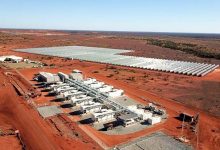It’s basically unheard of in Australia: An Australian mining giant announcing that it will choose wind, solar and battery storage to provide 80 per cent of the power needs of a proposed $1 billion nickel mine in outback Australia.
And it is now pretty clear that renewables made the difference between the project numbers on West Musgrave copper and nickel mine adding up for Oz Minerals and its junior partner, or not.
It’s unheard of, because this is the biggest commitment of any Australian miner to embrace renewables for a new project of this size, or even for any mine at this scale, despite the rush to embrace renewables at huge iron ore mines by the likes of Rio Tinto and Fortescue.
It’s unheard of too, because apart from a mention in the Adelaide Advertiser, we can’t see this significant event being reported anywhere else in mainstream media.
Last week, Oz Minerals held their analyst briefing to coincide with the release of their latest results, and it gave some valuable insight into why the company chose wind and solar and batteries over the conventional option of building a gas pipeline.
Both proposals lined up about equal in terms of “net present costs”, but Oz Minerals decided that the falling costs of renewables and storage, and the carbon count of gas generation, made the choice to go with renewables an easy one in the end. In short, going with renewables had a lot of upside. Choosing gas had a lot of downside.
Here’s what CEO Andrew Cole had to say when he was asked about this by the analysts, many of whom were curious about the choice of renewables to provide 80 per cent of the project’s power needs.
“At an NPC level, a gas pipeline with a gas supply versus a renewable energy farm with a renewal energy supply on the current flow sheet is actually quite comparable in terms of value. So they’re actually quite line-ball to one another,” Cole said.
“What you’d overlay on the top of these two things though are the assumptions you make about the future.
“So we know that renewable energy is getting more efficient, less cost to build them and producing lower-cost energy if you look backwards. Converse to that, what we know is there’s more pressure on carbon. You’ve got to start making assumptions about carbon price and gas price escalation.
“So I would articulate, from a very high level, that a renewable energy farm has probably more upside potential in it and a gas pipeline has more downside potential with it — to it, notwithstanding the risk around building a pipeline and transmitting gas versus building renewable energy farm and using that.
“So right now, they’re both viable options. I — we put our renewable energy farm in the base case because we think it’s very robust. And our aspiration, and I think all of our industry’s aspiration, needs to be reduced carbon from the sector. So this actually achieves it and in a quite a reliable way based on technology that’s being used elsewhere around the world already.”
And it has another added benefit.
One analyst wondered why the pre-feasibility study appeared to have higher capital costs than an earlier study. The answer is that the cheaper supply of renewables meant that Oz Minerals can now spend more upfront on more efficient Loesche Mills, which are more expensive to buy and install but will improve their through-out, and lower overall costs.
“There’s actually quite a lot of changes to give us the flexibility in the operation to take advantage of lower power costs when we use renewable energy,” Cole said.
“So that’s one of the primary reasons of using Loesche Mill, for example, as we get to campaign and operate the crushing circuit when you have lower-cost solar or wind and then switch it off.”








